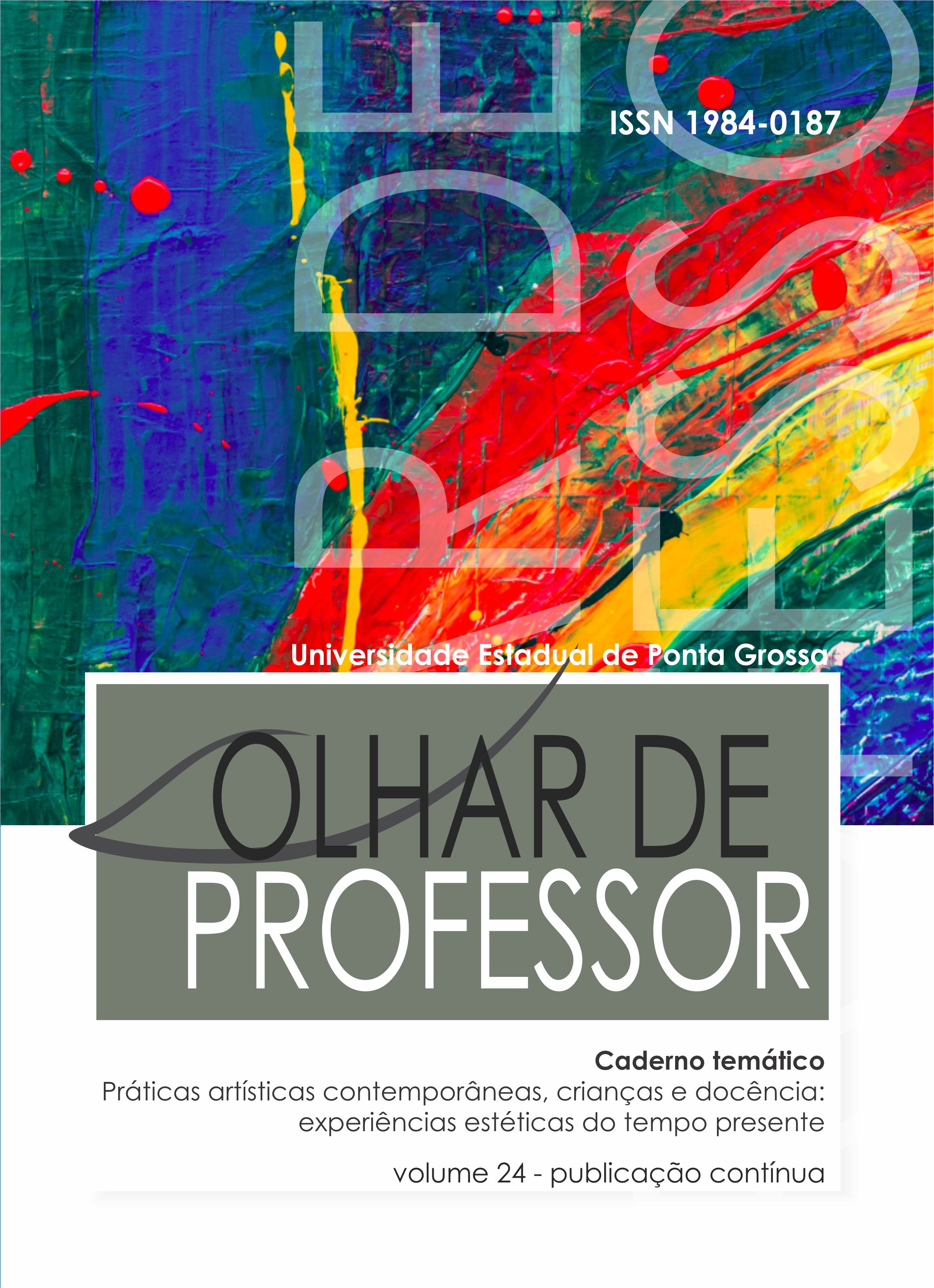Languages and materialities in contemporary art: the place of early childhood education and children in this debate
Main Article Content
Abstract
The purpose of this text is to discuss the different types of relationships between contemporary art, languages and materialities with children. For that, we mobilize concepts and experiences from which we discuss the multiple languages and materialities that are intrinsic in the children's experiences and that dialogue with the contemporary art way of being. For this debate we will discuss how the terms “different languages” and ‘Multiple languages” are present in official curricular documents in the city of São Paulo and Brazil. We will also discuss the specificity and possibilities that contemporary art offers for early childhood education.
Keywords: Early childhood education; contemporary art; materialities.
Downloads
Article Details
Authors who publish in this journal agree with the following terms:
a) Authors keep the copyrights and concede the right of its first publication to the magazine. The work piece must be simultaneously licensed on the Creative Commons Attribution License which allows the paper sharing, and preserves both the author identity and the right of first publication to this magazine.
b) Authors are authorized to assume additional contracts separately, to not-exclusively distribution of the paper version published in this magazine (e.g.: publish in institutional repository or as a book chapter), with the author identity recognition and its first publication in this magazine.
c) Authors are permitted and stimulated to publish and distribute their papers online (e.g.: in institutional repository or on their personal webpage), considering it can generate productive alterations, as well as increase the impact and the quotations of the published paper.
d) This journal provides public access to all its content, as this allows a greater visibility and reach of published articles and reviews. For more information on this approach, visit the Public Knowledge Project, a project that developed this system to improve the academic and public quality of the research, distributing OJS as well as other software to support the publication system of public access to academic sources.
e) The names and e-mail addresses on this site will be used exclusively for the purposes of the journal and are not available for other purposes.

This work is licensed under a Creative Commons Attribution 4.0 International License.
References
BORGES, Camila Bettim. Por entre os dedos: Arte e Crianças Contemporâneas. Dissertação
(Mestrado) Universidade Federal do Rio Grande do Sul. Faculdade de Educação. Programa de Pós-Graduação em Educação. Porto Alegre, 2013.
BRASIL. Diretrizes Curriculares Nacionais para a Educação Infantil. Resolução n° 01, aprovado em 07/04/1999.
BRASIL. Parâmetros Nacionais de Qualidade para Educação Infantil. v.1 e 2. Brasília/ DF, 2006.
BRASIL. Proposta pedagógica e currículo em Educação Infantil: um diagnóstico e a construção de uma metodologia de análise. Brasília, DF: MEC/SEF/DPE/COEDI, 1996.
BRASIL. Referencial Curricular Nacional para a Educação Infantil. Brasília, DF: MEC/SEF, 1998.
BRASIL. Diretrizes curriculares nacionais para educação infantil. Brasília/DF, 2009.
BRASIL. Ministério da Educação. Parecer CNE/CEB n. 20/2009 , de 11 de novembro de 2009.
Revisão das Diretrizes Curriculares Nacionais para a Educação Infantil, Brasília, 09 dez. 2009b. Seção 1, p. 14. Disponível em: http://portal.mec.gov.br/dmdocuments/pceb020_09.pdf . Acesso em: 10 out 2019.
BRASIL. Ministério da Educação. Secretaria de Educação Básica. Diretrizes curriculares nacionais para a educação infantil / Secretaria de Educação Básica. – Brasília: MEC, SEB, 2010. Disponível em: ttp://www.siteal.iipe.unesco.org/sites/default/files/bra-_educacion_infantil.pdf . Acesso em: 10 set. 2019.
COCCHIARALE, Fernando. Rumos da Nova Arte Contemporânea Brasileira. Programa Rumos, Itaú Cultural artes visuais 2001/2003. Janeiro 2002.
CUNHA, Susana Rangel Vieira.da Uma arte de nosso tempo para as crianças de hoje. In: CUNHA, Susana Rangel Vieira da & CARVALHO, Rodrigo Saballa de (Org,) A Arte Contemporânea e Educação Infantil. Porto Alegre: Mediação
DANTO, Arthur C. Após o fim da arte: arte contemporânea e os limites da história.São Paulo: Odysseus Editora, 2006.
DEWEY, John.John Dewey e o ensino de arte no Brasil. São Paulo: Cortez, 2002.
DEWEY, John. A arte como experiência. Trad. Vera Ribeiro. São Paulo: Editora Martins, 2010.
DEWEY, John. Experiência e educação. São Paulo: Editora Vozes, 2011.
HOYUELOS, Alfredo. La ética en el pensamiento y obra pedagógica de Loris Malaguzzi. Barcelona: Octaedro, 2004.
LARROSA, J. Notas sobre a experiência e o saber de experiência. Rev. Bras. de Educação. 2002, n. 19, p. 20-29.
LARROSA, J. Pedagogia Profana: Danças, Piruetas e Mascaradas. Tradução: Alfredo Veiga-Neto. 5. ed. Belo Horizonte: Autêntica, 2014
MALAGUZZI, L. History, ideas and basic philosophy: an interview with Lella Gandiniby Loris Malaguzzi. In: EDWARDS, C.; GANDINI, L.; FORMAN, J. (Ed.). Thehundred languages of children: the Reggio Emilia approach – advanced reflections.London: Ablex Publishing, 1998.
MALAGUZZI, L. Your image of the child: where teaching begins. Child CareInformation Exchange, Redmond, n. 96, 1994. Disponível em:
OSTROWER, Fayga. Universos da arte. Rio de Janeiro: Campus, 1987.
OSTROWER, Fayga. Acasos e criação artística. Rio de Janeiro: Campus, 1995.
OSTROWER, Fayga. Acasos e criação artística. Rio de Janeiro: Campus. 1999.
PAREYSON, L. Os problemas da estética. 3. ed. São Paulo: Martins Fontes, 2001
PINAZZA, M. A. John Dewey: inspirações para uma pedagogia da infância. In: OLIVEIRA-FORMOSINHO, J.; KISHIMOTO, T. M.; PINAZZA, M. A. (Org.). Pedagogia(s) da infância: dialogando com o passado, construindo o futuro. Porto Alegre: Artmed, 2007. p. 65-94.
RICHTER, Ivone Mendes. Multiculturalidade e interdisciplinaridade. In: BARBOSA, Ana Mae (Org.). Inquietações e mudanças no ensino da arte. 6. ed. São Paulo: Cortez, 2010. p. 85-95.
SÃO PAULO (Município). Secretaria Municipal de Educação. Coordenadoria Pedagógica. Currículo da Cidade: Educação Infantil. São Paulo: SME/COPED, 2019.






